Waimea Heights Primary 3/4BA WHPS

Hey Waimea Grade 3/4s!
Thank you for your questions about climate change. You asked some really interesting questions about ice, fish, reefs, extreme weather and atmosphere.
You'll find answers to your questions from our climate experts below - have a read and watch their answers.
You can also have a look at what other classes across Tasmania asked this year, as well as our climate change toolkit.
Our Questions
Climate change has many different parts to it and scientists have come up with lots of very promising ways to slow down global warming. Here is one super interesting solution that comes from the oceans.
Have you ever thought about seaweed? It isn’t just smelly stuff that builds up on some beaches, it’s an amazing marine plant that can help us tackle global warming! Seaweeds are plant-like organisms, which mostly live attached to rock in coastal areas. There are many different kinds of seaweeds, from fine delicate red seaweeds (phylum Rhodophyta) like asparagopsis , delicious and nutritious green seaweeds (phylum Chlorophyta) like ulva (which is also known as sea lettuce) to brown seaweeds (phylum Ochrophyta), like kelp. They also range in size from microalgae through the huge bull kelp macroalgaes.
Humans have been eating and using seaweeds for a very long time. Seaweed was a staple food in Japan, Korea and China since at least 600BC. The Icelandic sagas, written in the 10th century, also refer to dulse, a type of red seaweed, as a food. Special seaweed molecules call polysaccharides from red and brown algae are used in all sorts of human foods to help ingredients combine (emulsify) and as a thickener. These are even used in ice cream and toothpaste – next time you clean your teeth check the ingredient list for carrageenan – that’s derived from seaweeds.
But what about as a solution for climate change? To understand seaweed as a solution for climate change, we need to think about cow farts. Seriously, cows release a huge amount of methane into the atmosphere. Methane is one of the main greenhouse gases responsible for global warming and climate change. Cows produce a lot of methane. Just 1 cow can produce up to 120kg of methane in its lifetime, and there are about 1.5 billion cattle world word – that is a lot of cow farts.
Scientists at the CSIRO have worked out that just a small amount of dried asparagopsis (a red seaweed) fed to cattle can reduce their methane output by as much as 80%. Scientists have been working on this for a long time, but it is showing huge promise for stopping one source of methane getting into the atmosphere.
So the science is in and now companies are starting to invest in farming asparagopsis, and making feed additives for cattle.
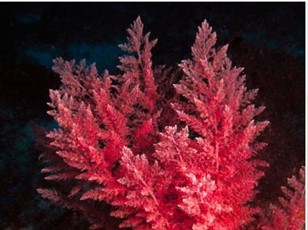
Stopping, or reducing climate change, known as mitigation, is something that is really important so I’m very glad you’ve asked how to do this.
Reducing climate change will involve lowering the level of greenhouse gases in the atmosphere. This means reducing the emission of heat-trapping greenhouse gases. This is done by reducing the use of fossil fuels and moving to renewable energy sources, like wind, solar and ocean wave energy instead. The effectiveness of these energy sources is improving all the time and around the world (especially in Australia) they are becoming a major source of energy already. Increasing efficiency and finding ways of reducing energy use and waste is also very important. Around the world businesses and governments are making commitments to reduce the use of fossil fuels and to transform manufacturing, food production and transport (e.g. trucks, cars, trains and shipping) to electricity or other fuels (like hydrogen).
Another way to help mitigate climate change is to support processes that actively remove carbon out of the atmosphere. Healthy oceans, forests and soil are great carbon stores. This means restoring and protecting these environments and supporting sustainable practices will help. Growing trees is a great way of helping remove carbon from the atmosphere. This effect is so large that the natural regrowth of Tasmania’s forests means that the state is currently a carbon sink – meaning more carbon is removed from the atmosphere than is emitted. This means as a state Tasmania is doing better than the net zero emissions target governments around the world are talking about.
Rather than just letting the trees do all the heavily lifting though we can help Australia and the world by reducing our individual emissions. On a personal level that means turning lights and appliances off when you’re not using them; putting on a jumper rather than turning the heating up to full; and walking, cycling, or using public transport if we can. Also finding out about what you eat and changing to options that contribute less to climate change can also help. Agriculture is a major producer of greenhouse gases so look for low carbon meals, such as sustainable seafood and local seasonal foods, and try having at least a couple of red meat free days a week.
In addition to reducing energy use we can also consume less (e.g. use clothes for longer rather than chasing the latest fashion look), increase recycling and appropriately dispose of organic waste (e.g. food scraps). Methane is a powerful greenhouse gas, over twenty years it is about 80 times more potent at warming than carbon dioxide. When food and garden waste is buried with general garbage the microbes and chemical processes that break the waste down cannot easily access oxygen and so they produce a lot of methane (known as anaerobic breakdown). However, if you put the organic waste into a compost bin (at home or one provided by the council) the microbes can access oxygen and so they use a process that produces much less methane (known as aerobic breakdown). The nutrient rich compost that results also means more plants can be grown (absorbing carbon) and less energy is needed to make artificial fertiliser. A win-win-win.
The biggest thing you can do to help climate change is to stay informed, to help share useful information and to think about your actions – each little bit really does help. Around the world innovations and action by young people is helping accelerate action to reduce climate change.
For starters, you might like to find out how Tasmania’s tree growth is helping our carbon budget. NASA also has a great page on climate change, which mentions some solutions. The United Nations also has some high-level information on different activities around the world.
You might also like to play with the simple climate model at en-Roads, explore options for reducing climate change
The climate was always changing, but it is important to understand that there is a big difference between natural climate change (or climate variability) and climate change due to human activities.
Natural climate change
Past natural climate changes have led to the extinction of many species, caused populations to migrate, as well as large changes to land temperatures, the amount of carbon dioxide and other greenhouse gases in the atmosphere, and ocean currents. In the last 800,000 years, for example, the Earth has gone through seven glacial cycles (ice ages), where the Earth was much cooler than today with expansive ice sheets covering much of the globe. At the end of each of these, the climate warmed, in some cases to warmer temperatures than today. The timing of these cycles is mostly controlled by slow changes in Earth’s orbit, which alter the way the Sun’s energy is distributed around the Earth.
Human-caused climate change
Humans have always affected and modified their environment but over the last 200 years, however, human activities have increasingly overridden natural climate processes, and since at least the middle of the 20th century, the warming we are seeing is undeniably a result of human activities. Our actions are causing rising carbon dioxide concentrations to levels higher than at any time in at least the last 800,000 years (see figure below), and rising temperatures in the atmosphere, ocean and on land are at a scale and rate never seen before. This is leading to the increasing frequency and intensity of extreme events such as bushfires, cyclones, heatwaves, floods and droughts we are experiencing.
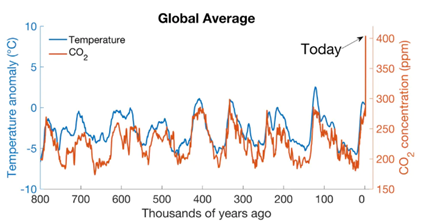
Climate change is caused by natural processes but also increasingly by human activities. The main driver of climate change is the greenhouse effect. Some gases in the atmosphere have a similar function to the glass in a greenhouse. The glass walls of a greenhouse let heat and light from the Sun in, which warms up the air inside. Similarly, greenhouse gases let the incoming heat from the Sun pass through to the Earth’s surface, where it is trapped. Many of these gases occur naturally, and natural causes of changes to the greenhouse effect include solar radiation and volcanic activity. But human activities are increasing the concentrations of some greenhouse gases in the atmosphere, in particular carbon dioxide, methane, nitrous oxide and fluorinated gases, leading to an enhanced greenhouse effect and warmer temperatures.
The main human activities causing these changes are:
- Burning of fossil fuels such as coal, oil and gas, which produce carbon dioxide and nitrous oxide
- Deforestation, which means that there are less trees to help absorb carbon dioxide from the atmosphere, and carbon stored in the trees is released to the atmosphere
- Increasing livestock farming, which is problematic as cows and sheep, for example, produce large amounts of methane when they digest their food
- Fertilisers containing nitrogen, which produce nitrous oxide emissions
- Fluorinated gases, which are emitted from equipment and products that use these gases, such as refrigerators, air conditioners and heat pumps
While natural processes play a role in how the climate changes, what we are currently experiencing cannot be explained by natural processes alone. Since at least the mid 20th century, humans are unequivocally causing climate change, and unless we modify how we live and how we interact with the environment around us, this will continue to be the case.
The how and the why of climate change are very tightly linked, so tightly linked people as far back as 1896 had figured out the basics of how it works. Earth’s atmosphere keeps the world warm by trapping heat. It does this in a way similar to the way a greenhouse works (thus the name “greenhouse effect”). Sunlight (and warmth) can come through the atmosphere in the day time and warms up the land and sea areas. At night cooling occurs, with the heat escaping into the atmosphere, some of that leaks out into space again, but not all because the atmosphere traps some of the heat. The key bit of the atmosphere that traps the heat are the greenhouse gases.
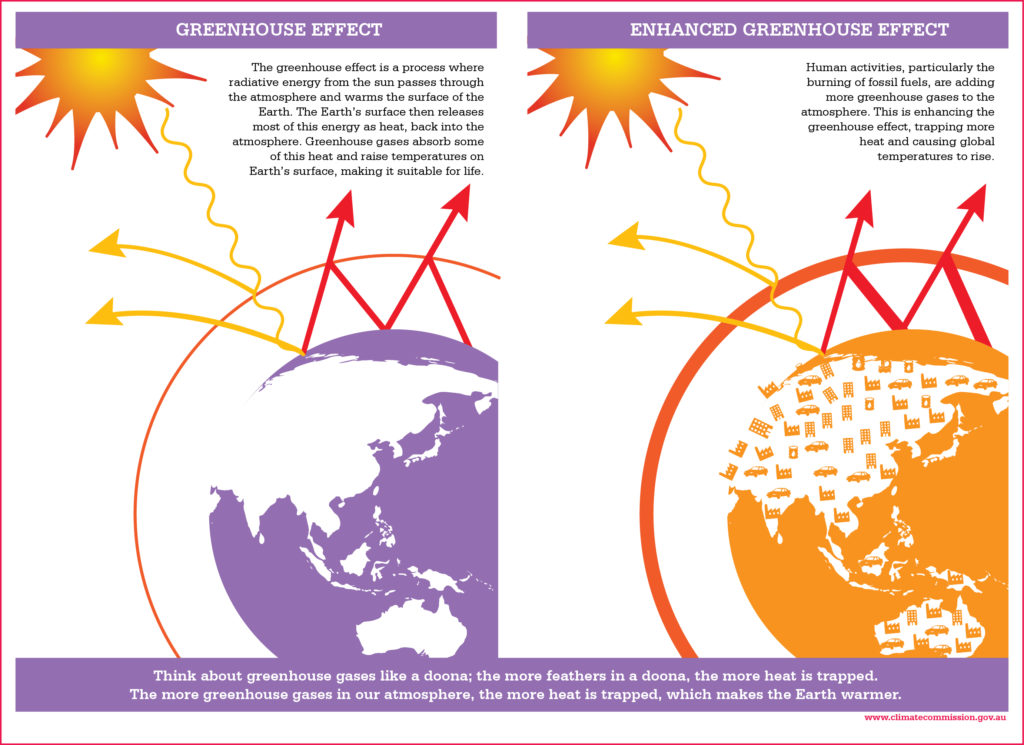
Natural greenhouse gases are water vapor, carbon dioxide, methane, ozone and nitrous oxide. These chemicals are an important part of the world’s natural cycles. They cycle between the atmosphere, the ocean, soils and rocks. Human activities have changed those cycles, meaning more greenhouse gases have entered the atmosphere, trapping more heat and leading to global warming and climate change.
Many human activities influence climate relevant cycles, but two of the most important are to do with carbon dioxide and methane. Fossil fuels contain carbon dioxide locked up millions of years ago, by bringing it to the surface and burning the fossil fuels human activity short circuits natural weathering and other cycles, creating one of the major sources of the excess carbon dioxide that is creating climate change.
Agriculture is also a major contributor to climate change, producing about a quarter of all current greenhouse gas emissions. These emissions come from the fuels used by farmers, but also because of emissions from rice paddies and livestock, which produce methane. A particularly powerful greenhouse gas, over a 20-year period methane is 80 times more potent at warming than carbon dioxide. On top of this, the removal of native vegetation, like forests, to create space for agriculture reduces the amount of carbon drawn out of the atmosphere and stored in trunks and roots as trees grow (known as sequestration).
As you can see there are many interconnected ways that human activities are influencing the biogeochemical cycles of Earth and thereby contributing to climate change.
Good sources of climate information are https://climate.nasa.gov/ and the new IPCC climate atlas https://interactive-atlas.ipcc.ch/
Two good Australian information sources are the CSIRO https://www.csiro.au/en/research/environmental-impacts/climate-change/Climate-change-QA and the Academy of Science https://www.science.org.au/education/immunisation-climate-change-genetic-modification/science-climate-change
You might also like to play with the simple climate model at en-Roads, explore options for reducing climate change https://en-roads.climateinteractive.org/scenario.html?v=21.10.0
I’ll focus on the greenhouse gases, the ones that cause climate change, with the main ones being carbon dioxide (CO2), nitrous oxide (N2O), and methane (CH4). Scientists started measuring CO2 in the atmosphere in the late 1950s, collecting flasks of air from a mountain in Hawaii. These measurements are a pretty good indication of CO2 in the whole atmosphere, because the gases in the atmosphere get mixed around quickly and have about the same concentration everywhere. This graph (from here: https://gml.noaa.gov/ccgg/trends/) shows the CO2 measurements from Hawaii:
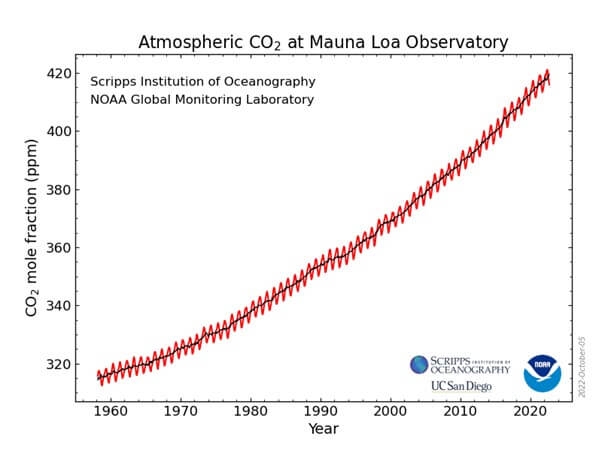
You can see the CO2 concentration has been increasing ever since the measurements started. It was 316 ppm in 1958, 327 ppm when I was born in 1971, 385 ppm in 2007 when my twins were born, and 416 ppm in September 2022. See if you can use the graph to work out what the CO2 concentration was when you were born. There’s an interactive version here: https://gml.noaa.gov/ccgg/trends/graph.html
Over time scientists began to make measurements at more places around the world, including in Tasmania. This graph shows CO2 concentration at Cape Grim since 1984:
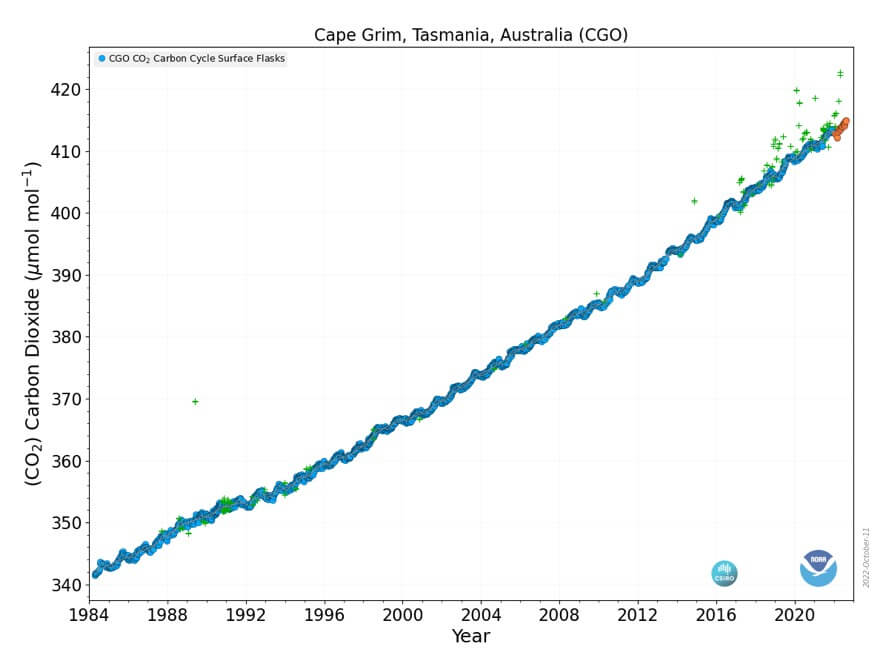
Finally, we even know how gases changed before scientists started collecting samples from mountains. This information comes from bubbles trapped in ice cores, which preserve the air that was around at the time the ice formed. The oldest of these ice samples are 800 thousand years old! The graphs below, from the IPCC 6th Assessment Report, show greenhouse gas concentrations going back 800,000 years. The data on the right-hand side, showing ‘ambient air’, is from flasks like in the graphs above.
What you can see from these graphs is that
- Greenhouse gas concentrations varied quite a lot even when there were no humans around
- Greenhouse gas concentrations have increased very quickly since 1900 (notice that the timescale on the right is expanded compared to the others)
- The concentrations of CO2, CH4 and N2O are higher now than they’ve been at any time in the past 800,000 years.
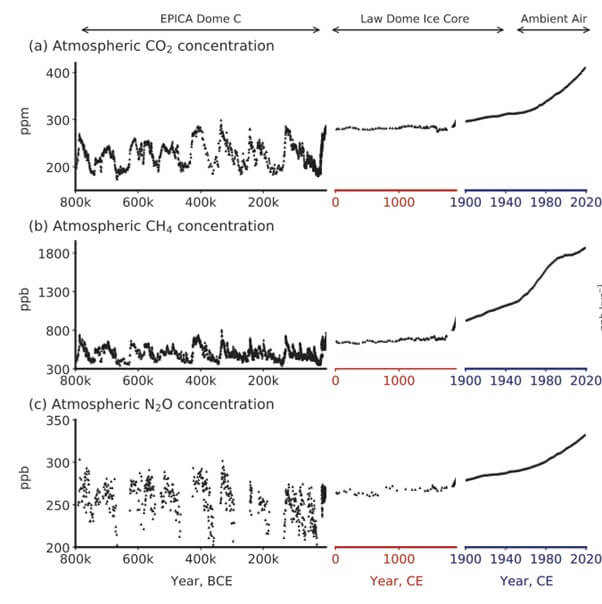
There is a great animation available on youtube that shows how CO2 in the atmosphere has changed.
This is an important question because it underlies what we know about the rate and level of current greenhouse gas emissions.
A lot of what we know comes from ice cores. Ice cores are excellent recorders of atmospheric gases like CO2. In the figure below (Figure 1) you can see measurements of CO2 based on gases collected from the atmosphere by specially made instruments(red and blue lines).These instruments have been used to monitor atmospheric concentrations since 1950 and the measurements align extremely well with what the ice cores from Antarctica are telling us. Therefore, we’re confident about what the ice cores say about CO2 concentrations hundreds, and thousands of years ago.
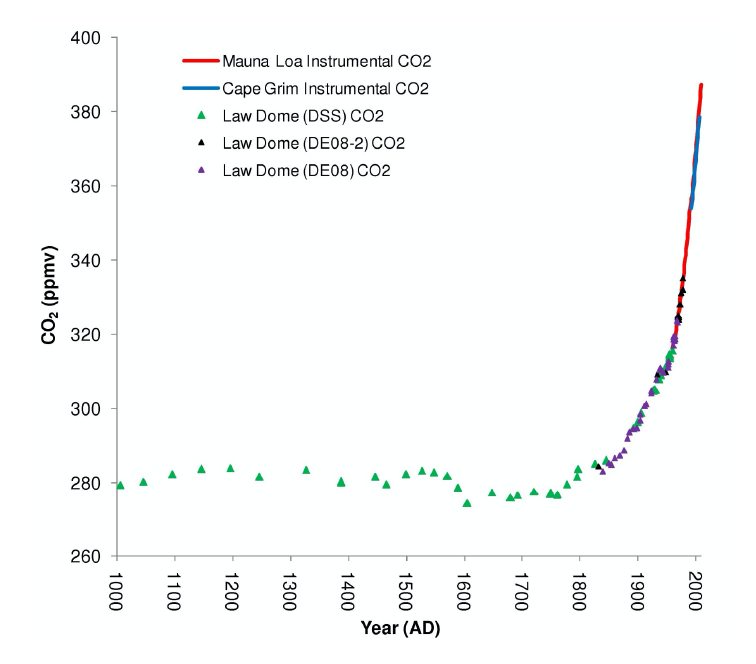
And how do we get CO2 concentration from ice cores? Ice has little bubbles of air in it.
These bubbles of air trapped in the ice core record what gases were in the atmosphere at
that time. As the next year’s snow falls, the older snow gets compacted, but the air bubbles
are still there. This process continues year after year, decade after decade, century after
century and so on.
Then an ice core scientist comes along and drills an ice core (long cylinder of ice) to collect
information about past climate from the ice. They use a lot of fancy machines to first work
out how old the ice is at points all the way down the core. They then extract the gases from
the air bubbles in the ice to work out what the gases are, and the quantities of different
gases along the core – from the youngest ice at the top all the way back to the oldest ice at
the bottom of the core. This provides a picture of how greenhouse gases have changed over
time.
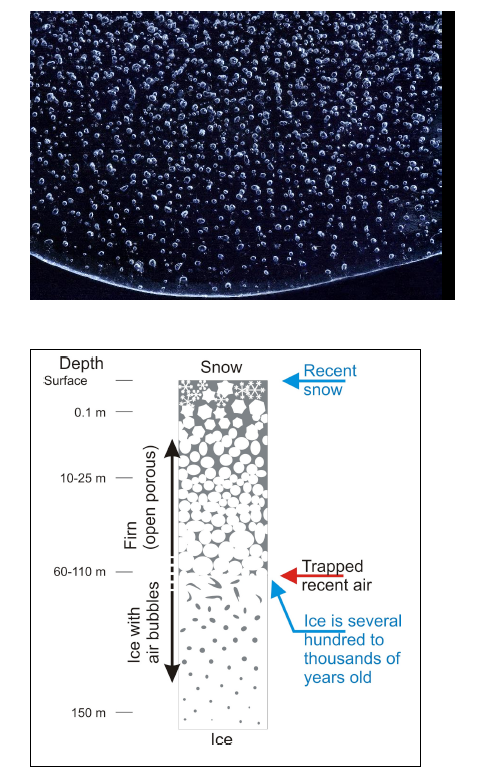
Figures supplied by Dr Tessa Vance, IMAS, UTas
Forests are habitats that are dominated by trees, these being plants that are woody and generally above 2 metres in height. The trees are dominant in the forest, but there are also the other smaller plants such as shrubs, herbs and ferns that form the ‘understorey’ of the forest (i.e. ‘under’ the canopy-forming trees). Then there are also the organisms that live in the soil, both above and below. These include countless number of invertebrates that live on the forest floor, both amidst the forest litter, made of debris such as leaves, bark, twigs and flowers/seeds, and in the soil (imagine some of the insects that live your garden soil!). And let us not forget the larger animals that also live in and depend on the forests, such as some of our mammals and birds.
The process of deforestation involves clearing of the forest (hence the ‘de’ in it!). The clearing mainly targets the trees in the case of forestry which involves growing and re-growing of trees so we can harvest the timber form the trees for various uses (e.g. building, paper-making). In other cases, such as happened in large parts of Australia and in other parts of the world such as the Amazon forests, clearing involves completely removing the trees, understorey plants, debris etc. to make way for other land uses such as producing food and fuels. Deforestation also occurs widely to make way for housing developments and associated infrastructure. These distinctions are useful as depending on the reason and nature of deforestation, and what aspects of the forests are cleared, the impacts on the atmosphere (and biodiversity) varies.
For example, if deforestation involves clearing of the trees, other plants and the debris, making way for houses and roads, all of the carbon stored in the landscape (both above and below the ground) is now potentially released back into the atmosphere thereby adding to our historic global greenhouse gas (GHG) emissions. Furthermore, by replacing a functioning forest habitat with a housing sub-division, the ability for those trees and other organisms to continue to take carbon away from the atmosphere and store it in the form of wood and other biomass has been compromised. Within forestry, depending on the nature of forestry practices, again large amounts of carbon can be lost into the atmosphere (where it is causing us harm) and also lost is our ongoing ability to remove harmful pollutants from the atmosphere and store it safely in the form of forest carbon.
The solution therefore is to manage our forestry practices in such a way to provide a net sink (not source) of carbon dioxide (which is a GHG). In other landscapes, the more we can integrate trees and other plants in creative ways, the more we can help remove carbon dioxide from the atmosphere, and also help us cool our cities, bring back birds to our backyards, and gain other benefits of experiencing nature in our daily lives.
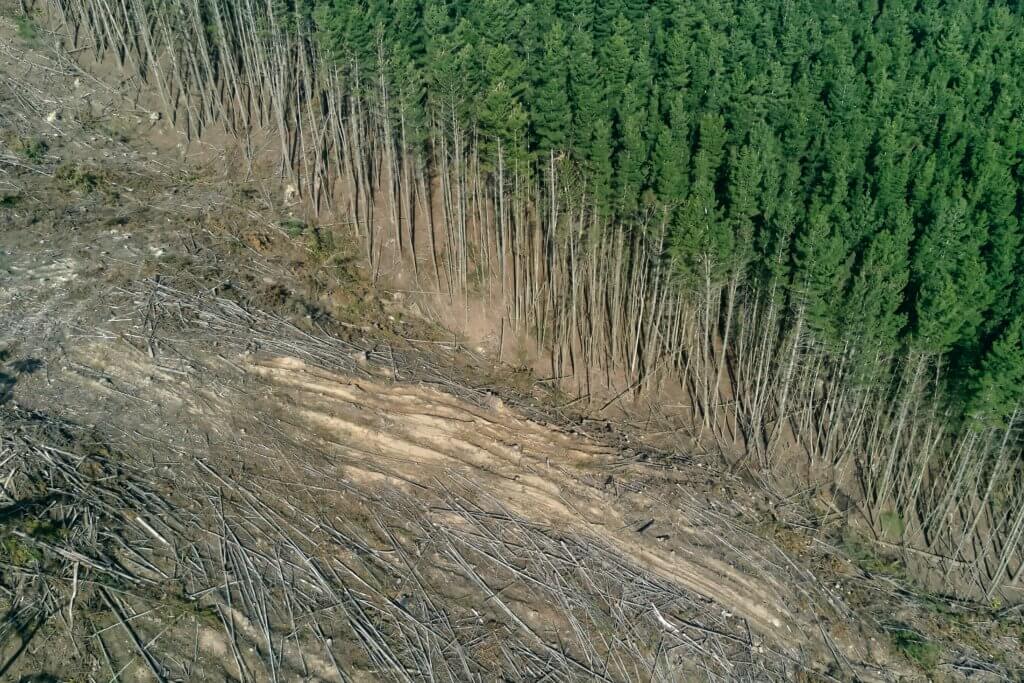
Antarctica is a continent of rock that is covered by ice and surrounded by the Southern Ocean – this sets it apart from the Arctic, which is all sea ice and no land. Human activities elsewhere are impacting upon Antarctica and in particular the Antarctic ice – for instance, traces of the industrial revolution can be found within ice cores from the Antarctic, dating to before humans had set foot on the continent. That means we were influencing the place before we even knew that it existed. Now Antarctica is one of the most surveyed places on earth, thanks to mapping, monitoring, and satellite technology. If there was no Antarctica at all, the world’s ocean currents would behave differently. There would be no circumpolar current, and no cold bottom water to drive the circulation of the currents from the south. The animals that live in Antarctica would not have a habitat, so we would have less biodiversity on earth.
It is important to take care of Antarctica because it is a home for many species of animals, such as penguins and seals, and the surrounding oceans are home to whales and krill. Antarctica plays a key role not only for the creatures that call Antarctica and the Southern Ocean home, but also for people who live in far-away places. For instance, melting ice sheets in Antarctica can contribute to sea level rise on distant tropical islands. That means it’s not only scientists who have a role to play in speaking up for and protecting Antarctica – we all have some responsibility. There are many ways to connect with Antarctica from back home – these include participating in citizen science projects (such as counting penguins on Penguin Watch), learning about the similarities between Australia and Antarctica (such as how to identify the trees that have been found in fossils in Antarctica), or enjoying books and films about the continent. The Antarctica that lives in the public imagination is shaped by these sorts of inputs and is super important because most people never visit the continent.
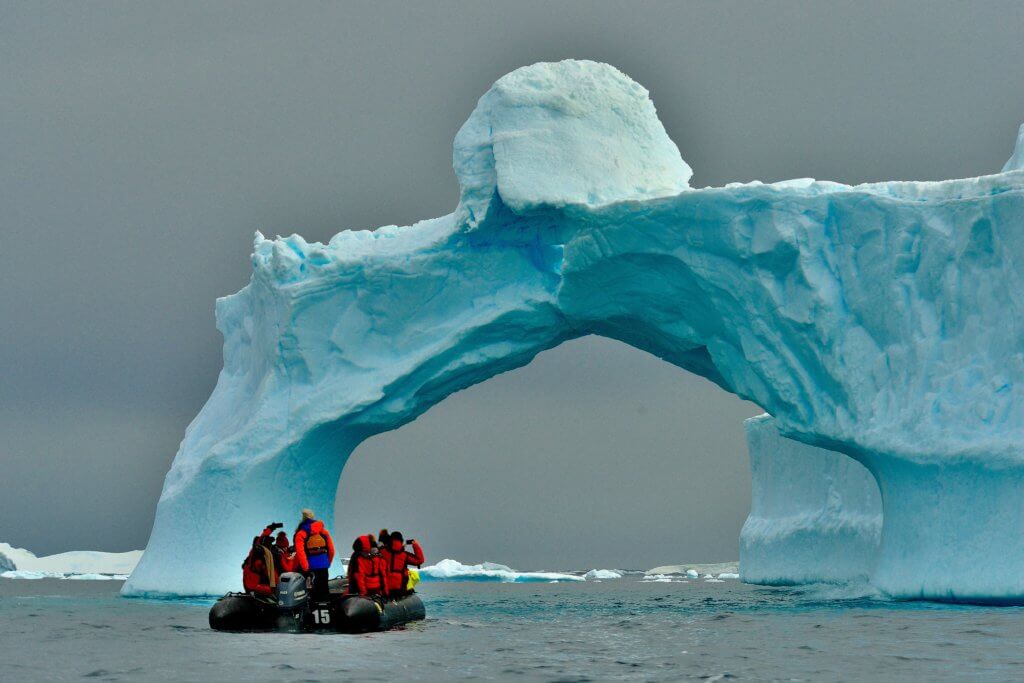
If all the ice at the poles melted, the sea level would rise by nearly 70m. Because there is so much ice, it takes a very long time to melt it all. But it is currently melting, causing the sea level to go up by about 2 mm every year. At the current rate, we will all be long dead from old age before they are fully melted. But what happens to our children and the world they live in?
As the sea level goes up, some coastal cities and towns will start to flood and the higher sea level will erode the land from underneath the buildings. There will be difficult choices in the future; we will need to decide what gets left behind as we move to higher ground and what we try to save.
This is an important question because if we know how climate change affects these environments, we can identify ways to prevent further damage and to help these environments to bounce back. But before we dive into the how, check out this question 'will all the reefs die?'
It’s good to remember that not all reefs will be destroyed! However, climate change is increasing water temperatures and acidity which impacts the species that call reefs and trenches home.
In tropical coral reefs, warmer waters, heatwaves, freshwater flooding events, and changes in nutrients from pollution cause coral bleaching. Corals are skeletons, built from calcium and carbonate from the water around them, and are home to algae which provide nutrients to keep the coral healthy and gives the coral a brown/golden colour. When the water is too warm, the relationship between coral and algae breaks down and the stressed coral expels the algae, meaning it loses its primary food source and colour - this is known as coral bleaching. Corals are also changing in response to another impact of climate change, called ocean acidification, where the pH of the water lowers as the ocean absorbs carbon dioxide. This makes calcium minerals less available to animals including corals, that need these minerals to grow shells or skeletons. Unhealthy coral is also stressful for other species that depend on the reef for food and shelter.
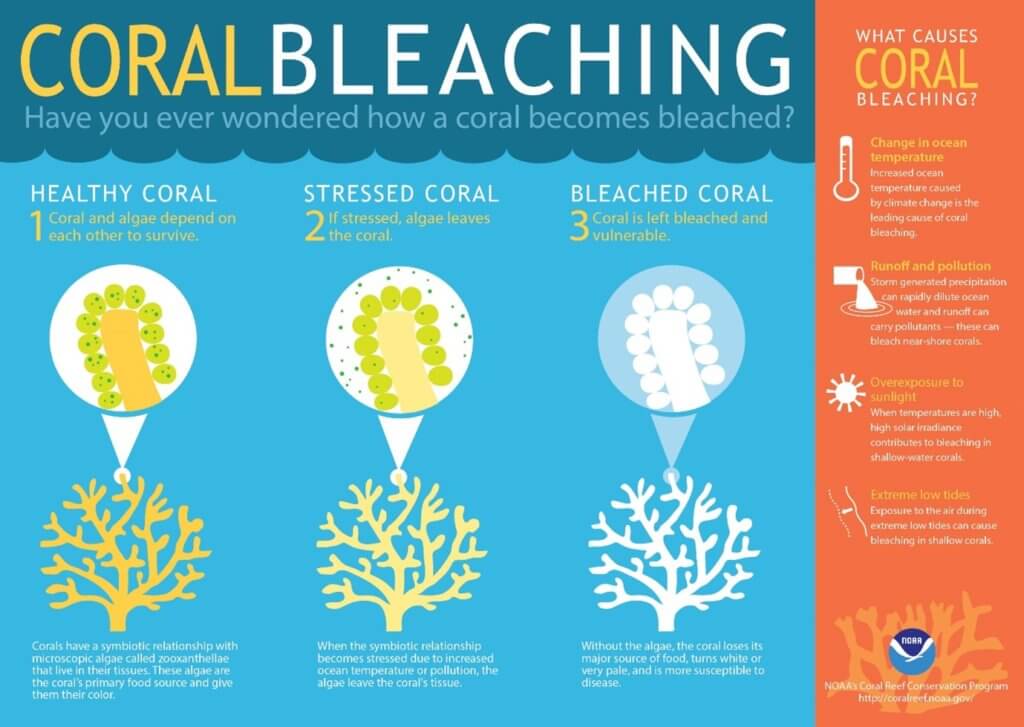
To hear more about coral reefs (and how jellyfish move!), have a listen to this episode of the Dr Karl Podcast where the Chief Scientist of the Great Barrier Reef Marine Park Authority explains how climate change is affecting the Great Barrier Reef.
In temperate reefs (with kelp and seaweeds) increased water temperatures with lower nutrients are preventing some species from growing and encouraging other species to evolve or move. Off Tasmania’s east coast, the warm waters of the East Australian Current have been moving south, reducing the giant kelp and introducing other species usually found in places with warmer climates. To help restore the reefs, researchers at the University of Tasmania have been successful in planting kelp that is more resistant to warmer temperatures - check out this video for more details.
Deep sea trenches are also experiencing increased temperatures and ocean acidification. Some deep-sea trench dwelling species will be unable to adapt to these changes, whereas other species may move into these environments. Deep sea trenches and their species recycle and channel nutrients back to the surface, and changes in these environments is likely to have flow on effects across the whole water column (from the seafloor to the surface). Extra human pressures from pollution, deep sea drilling for oil and gas, mining and fishing will add further stress to these environments. Limiting human activities in the deep sea will give these creatures the best chance to adapt to change, and right now, the United Nations are currently discussing an agreement known as the Treaty for Marine Biodiversity of Areas Beyond National Jurisdiction, to improve ocean management and increase protection.
The short answer is no. However, reefs will change from how we know them today. When considering reefs, the two major types of reef in Australia are tropical coral reefs and temperate rocky reefs, home to kelp forests. Both these reef systems are sensitive to ocean warming and marine heatwaves and both have experienced extreme impacts in the past decade. For example, almost 100,000 Hectares, equivalent to 2.3 million basketball courts of kelp forests were lost in Western Australia in 2011 following an extreme marine heatwave. In the tropics, marine heatwaves in 2016 and 2017 resulted in severe coral bleaching and death on the Great Barrier Reef.
As oceans warm, these extreme events will become more frequent and species that are already living close to their upper thermal limits are likely to suffer. In Australia, species on both coral reefs and kelp forests have evolved for millions of years under remarkably stable climate conditions. Unlike on land where temperatures can fluctuate by over 30ºC in a year, in the oceans around Australia, temperatures may only fluctuate by 5-10ºC. As a consequence, many species have limited scope to deal with changes in temperature. On top of this, south-eastern and south-western Australia are warming 2-4 times faster than average, making these regions particularly vulnerable to change.

In response to changing ocean conditions, species can either move to cooler habitats, adapt, or die. Many species are unable to move or adapt fast enough to escape the warming, or the impacts of a sudden marine heat wave. For the species that can move elsewhere, they may be able to survive in their new habitat, but in doing so may be lost from the reefs they have departed. As a result, there will be a change in the types of species that we see on reefs, with increasing numbers of warm water species in places like Tasmania, and a loss of the traditional cool-water species. Giant kelp is one example of this, which has decreased by 95% on Tasmanian reefs in recent decades. Even in the tropics, many heat tolerant species will survive, but it might not be all the colourful corals and fishes that we think of today.













